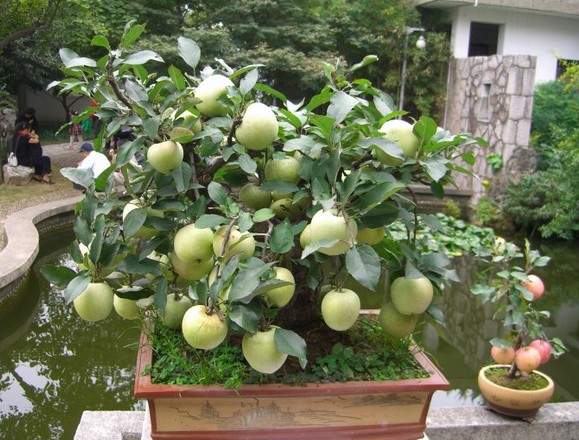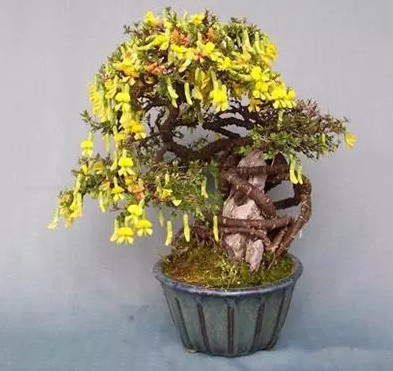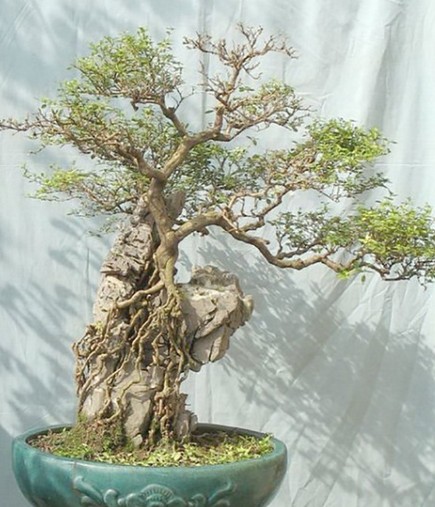Pruning methods of bonsai of fruit trees in winter
Winter pruning, also known as dormant pruning, is the pruning of the dormant period from the fallen leaves of fruit trees to the sprouting of spring flower buds. The so-called "winter pruning trees are prosperous" at this time, most of the nutrients have been transferred from the branches and leaves to the main branches and roots of the fruit trees for storage. Pruning causes the least nutrient loss and less damage to the fruit trees. Because there are no leaves, it is easy to observe and analyze the crown structure and predict the crown shape after the new shoot grows, which is beneficial to the modeling. Therefore, winter pruning is an important period of fruit tree bonsai pruning, the main content and task is the whole crown modeling of fruit tree bonsai.

Retraction pruning, or shrinking pruning for short, is to cut off part of the perennial branches. The key to retractive pruning is to look at the thickness of the retracted branch and the strength of the cut branch, and master the reduced part. The bare leg branch retracts, and the shearing branch remains flat or drooping branch, which can promote its branch to reduce the height or reduce the crown. The method of "swinging braids" is used when the perennial branches with branches are retracted, that is, the short branches are left under the cutting mouth to enhance the strength of "controlling the front and promoting the back" and speed up the sprouting growth of the rear branches.
Retract the annual or unformed mid-oblique branches to the blind spot (that is, the junction of spring and autumn shoots), "wear a living cap" for the strong branches (leaving a few buds above the blind nodes), and "wear a dead cap" for the weak branches (the middle shears at the blind nodes, above do not leave buds), can promote its early fruit The growth and fruiting cause the perennial fruiting branch or fruiting branch group to droop and overlap, plus the "peripheral advantage" fruit part moves out year by year, the crown is loose, strong outside and weak inside, the pruning turns the main head, the cutting branch stays strong, and raises the angle. it can renew and rejuvenate the crown, adjust the crown structure to make the crown balanced and compact, control the crown size, and achieve the ideal crown type.
Sparse shearing
Also known as sparse pruning, that is, perennial or annual branches are all removed from the base, it is often used to form disease and insect branches, dry and withered branches, thin and weak branches in the crown, dense clump branches, cross-overlapping branches, peripheral contact development branches, auxiliary branches, and non-valuable branches that are too straight or too prosperous to affect the tree type or can not be used, in order to improve the ventilation and light transmission conditions of the crown, enhance light intensity, increase photosynthesis, and create the accumulation of nutrients.
Thinning has a weakening effect on the potential of fruit trees, and the larger the cut, the greater the weakening effect, so it is necessary to measure it as a whole. Concretely follow the principle of "sparse and thin, weak and strong", therefore. To master the growth strength, thickness and quantity of thinning branches is the key to the construction of thinning branches. When the branches are thicker and there are a large number of branches, they should be carried out in batches, several branches this year, and a few more branches next year. Do not remove too many branches at a time, and do not cause "mouth injuries" so as not to weaken the fruit trees too heavily and cause weakness and death.
Long release
Long-term release, that is, slow release, throw, that is, do not cut some annual branches, let it continue to grow. The key to long growth is to master the growth and subordinate relationship of long branches: when backbone branches are weak and auxiliary branches are strong, backbone branches should be grown, auxiliary branches should be controlled and their growth should be weakened; when there are more long branches and strong branches and a large amount of them can be removed at one time, a small number of long and prosperous branches can also be grown, but they must be combined with summer pruning to control their growth. If the growth is still prosperous in the second year after growing, it is feasible to cut short or remove. After putting the fruit for a long time, it should be retracted or truncated according to different conditions, such as tree species, variety, growth and so on, in order to renew and rejuvenate.
Do not keep it for years or only without cutting, so as not to cause crown disorder and unclear levels. At the same time, the branches are airtight, which is not conducive to ventilation and light.
Truncation
Short cut can germinate lateral buds under the cut mouth and promote branching.
According to the length of the cut branches, it can be divided into light truncation, medium truncation, heavy truncation and extremely heavy truncation. If the weight is different, the reaction after pruning is also different. Light short cutting leaves long branches, many bud holes, and nutrients are not concentrated, which is easy to send out more medium and short branches, which is beneficial to the formation of flower buds; the middle and short cutting accounts for about 2/3 or half of the spring shoots, and the middle and long branches issued after cutting are more, and the growth is stronger, which is generally used for the culture of large branches or the rejuvenation of weak branches; the heavy and short cutting leaves are short and promote the emergence of cutting buds, which is suitable for the culture of branches or the regeneration of branches. The remaining part of the extremely heavy short cut is shorter, leaving only one or two shrunken buds, the branching ability is weak, the branch position is low and close to the trunk, which is suitable for the treatment of erect branches, overgrown branches and competitive branches, making the crown compact and conducive to crown renewal.
When there are too many bonsai branches of fruit trees, it is easy to cause scattered nutrients, lack of internal light, poor fruit quality and so on. Therefore, before the sprouting of fruit trees in spring, cross branches, overlapping branches, disease and insect branches and overgrown branches should be cut off, which is basically consistent with the pruning of other orchid gardens, which is called basic pruning. In the summer fruit growth period, by coring, sprouting, cutting and other means to control the tree shape, and to prevent the formation of apical dominance, to promote the growth and expansion of fruit. In autumn, in order to improve the ornamental effect of bonsai of fruit trees, we should give priority to shaping, cut off the branches that affect the ornamental effect, and remove the leaves that cover the fruit.
Time: 2019-06-13 Click:
- Prev

Cultivation of Caragana bonsai
Caragana arborescens is generally propagated by sowing. The seeds of Caragana are mostly ripe in early August. When the fruit turns dark yellow, it should be picked in time. If it is picked too late, the seeds will collapse due to pod burst and it is not easy to harvest. Put the harvested pods in the sun to dry, so that the seeds fall off naturally.
- Next

Seedling raising method of snow bonsai in June
The production of snow bonsai in June can be propagated by cutting method or split method. The split method, in which new individuals are obtained by separating the sprouting plants of June snow, is usually carried out in March in spring. Propagation is mainly based on cuttings, and natural old piles can also be used. Softwood or hardwood can be used in cuttings. Softwood cuttings are carried out in early summer every year.
Related
- Fuxing push coffee new agricultural production and marketing class: lack of small-scale processing plants
- Jujube rice field leisure farm deep ploughing Yilan for five years to create a space for organic food and play
- Nongyu Farm-A trial of organic papaya for brave women with advanced technology
- Four points for attention in the prevention and control of diseases and insect pests of edible fungi
- How to add nutrient solution to Edible Fungi
- Is there any good way to control edible fungus mites?
- Open Inoculation Technology of Edible Fungi
- Is there any clever way to use fertilizer for edible fungus in winter?
- What agents are used to kill the pathogens of edible fungi in the mushroom shed?
- Rapid drying of Edible Fungi

